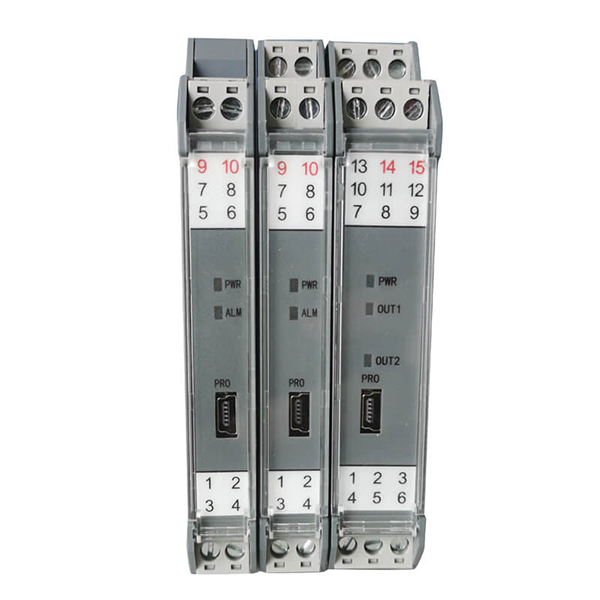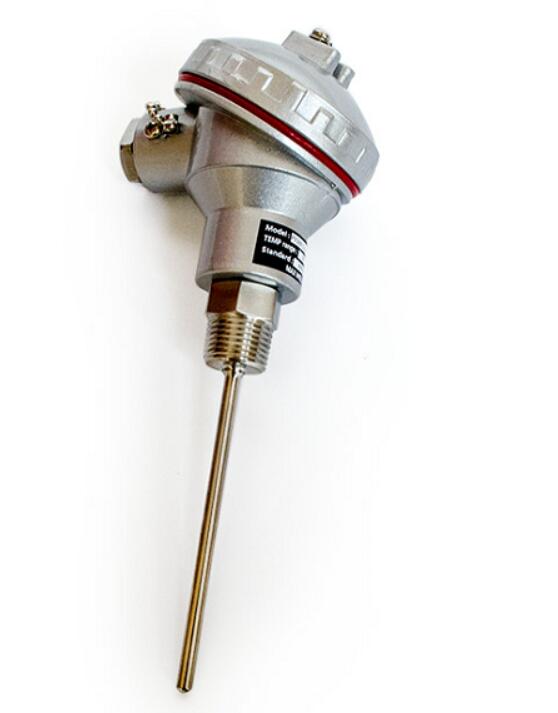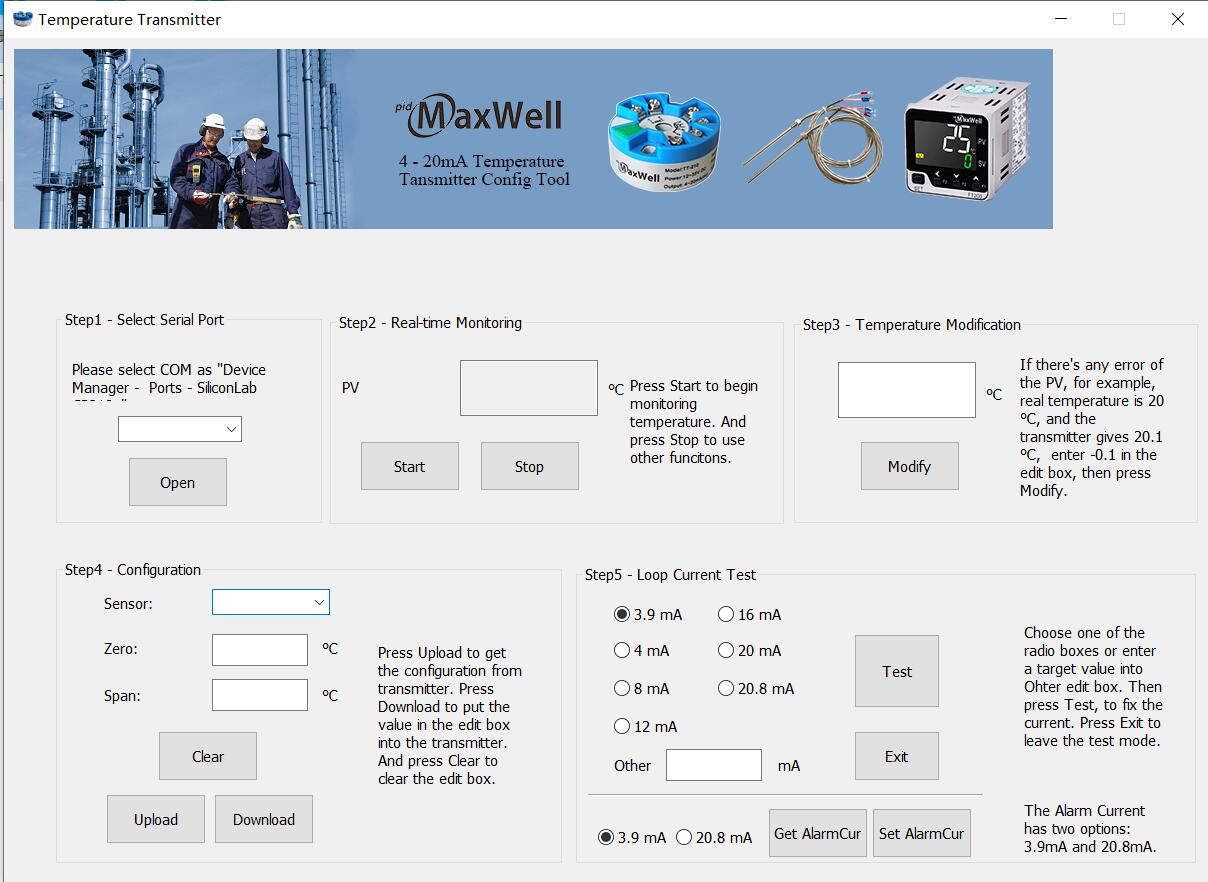-
Tel : +86-592-6382791
-
Email : sales@pidmaxwell.com
Tel : +86-592-6382791
Email : sales@pidmaxwell.com
Selecting correct temperature transmitters could be quite challenging from time to time, there are a lot of factors needs to be take into consideration, but first and foremost is to make sure that the measurement accuracy and to convert a temperature sensor’s low-level (ohm or mV) signal to a standard 4-20mA current signal that can be readily accepted by a monitoring and control system, such as a DCS or PLC
The evolving technology has made the temperature transmitter reliable, affordable, below are the few things should be taken into consideration when choose the correct temperature transmitter.
1. Back of Panel or Local Installation
Perhaps the most important consideration when specifying a temperature transmitter is the environment in which it will be installed. If the distance between the sensor measurement and the control room is relatively short and free of plant electrical "noise", temperature transmitters can be inexpensively installed in the control room, with sensor extension wires leading to them. These transmitter configurations are called DIN-style or rail- mount housings (Figure 1). For economy reasons, multiple high-density DIN-style transmitters are installed on a mounting rail in a multi-unit protective enclosure, and are powered by a common power supply.

Figure 1. Rail-mount housings are typically mounted on a surface or in a multi-unit protective enclosure.
If a long distance exists between the sensor and the control room, or if plant noise will adversely affect the sensor’s relatively "weak" low level signal, the temperature transmitter should be installed as close to the sensor as possible. This will allow the sensor signal to be conditioned and converted to a more robust 4-20mA signal better able to withstand long-distance transmission through a "noisy" plant.
For these applications, transmitters are installed individually in field-mountable enclosures called connection or thermowell heads (Figure 2). To accommodate corrosive, caustic, hazardous, hose down, or just plain nasty weather conditions, connection heads come in a variety of shapes and materials including aluminum, stainless steel, iron, and plastic. Where ambi-surement will be. Much worse, with fixed range transmitters, if you must change to a different sensor type, you are out of luck.

Figure 2. Field-mount housings accommodate corrosive, caustic, hazardous, hose down or just plain nasty weather conditions.
Microprocessor-based universal transmitters offer a vast array of operational advantages at prices just slightly higher than many of their restrictive fixed range counterparts. Most important of these is the ability to be set up to handle a wide range of different sensor types and temperature ranges. This may include thermocouples (J, K, E, T, R, S, B, N, and C) and RTDs (2-, 3-, and 4-wire; Pt, Cu and Ni; 10 to 1000 ohm), and temperature ranges within –328 to 1562°F (-200 to 850°C). Universal transmitters can be set to monitor any range within the sensor’s established curve. Therefore, you can set the transmitter to "concentrate" on the exact range important to your process.
One transmitter type can be specified and stocked to handle every application in the facility. If you (like most) use many different sensor types, have had to change the type of sensor you use, or are just not certain what may happen in the future, universal transmitters are a much more flexible way to go.
Figure 3. For surface measurements, the sensor and transmitter may be clamped, strapped, bolted or welded directly to the measurement point.
2. Configuration Method
Available universal temperature transmitters can be configured using on-board controls, hand-held configurators, and/or with PC software. On-board controls provide the advantage of not having to rely on external devices to perform set up. However, the configuration options available are sometimes very limited.
Hand-held configurators are usually associated with smart instruments, such as smart HART® temperature transmitters. They provide the advantage of being able to re-configure the transmitter from any convenient termination point along the 4-20mA loop. The disadvantages are that hand- elds can be less than intuitive, expensive (over $2500), and sometimes can only be used with one type or class of instrument.
PC configuration is the most versatile, and by far the easiest and fastest to use (Figure 4). All operating parameters, even complex custom sensor linearization tables, can be easily selected from a software window and downloaded to the transmitter in a few minutes. A great PC costs less than many hand-helds, and can be used for numerous other purposes. The only drawback is that the transmitter must be taken to the PC, or a laptop must be taken to the transmitter, for configuration.

Figure 4. PC software allows transmitter configuration in just a few minutes.
3. Accuracy and Stability
Temperature transmitters differ greatly in measurement accuracy. At the low end, you can expect accuracies of ±1°F. At the high end, some transmitters deliver amazing accuracies of ±0.025°F. Many factors can influence overall accuracy including: input accuracy, output accuracy; resolution; linearity; load effect; line voltage effect; cold junction compensation (for thermocouples); repeatability; ambient temperature effect; EMI/RFI effect; and sensor lead resistance effect. Complicating matters, the way that stated accuracy is determined differs from manufacturer to manufacturer.
When doing accuracy comparisons, keep in mind that some vendors use the term linearity in place of accuracy. Others will state that the accuracy specification includes linearity and repeatability, and assumes errors caused by fluctuating ambient temperature conditions. Still other specifications are stated in terms of a selected temperature range, temperature reading, or measurement span. Be sure to read the fine print so that you can properly determine the accuracy of a given transmitter under the conditions it will operate. The degree of accuracy required for your application is, of course, dependent on the nature of the process itself. In general, the higher the accuracy is, the more certain the outcome of nearly every process.
Whereas accuracy is the level of uncertainty of a transmitter’s output at a given time, stability is the uncertainty of a transmitter’s or sensor’s output over a period of time. Stability (usually specified as a percent of temperature span per year) will help you tell how often your system will need routine calibration. Typical long-term stability specifications provided by manufacturers range from 6 months to 5 years.
4. Sensor Selection
Your temperature transmitter supplier should be able to recommend the best sensor for your application. In general, an RTD will give you a more accurate, stable temperature measurement than a thermocouple (T/C), provided the somewhat more fragile RTD can withstand the environment.
An RTD or T/C output will change due to temperature cycling, temperature swings, corrosion, lead wire degradation, moisture, and contamination. Where possible, use 4-wire RTDs, and specify a temperature transmitter that is able to accept a "true" 4-wire RTD input. The advantage is that the fourth wire in a RTD circuit effectively cancels out errors due to resistance imbalances between the leads. Every ohm of imbalance in an RTD’s lead wires results in as much as a 2.5°C measurement error.
5. RFI/EMI Protection and Signal Isolation
Always specify a transmitter with a stated RFI/ EMI immunity specification. The effects of Radio Frequency Interference (RFI) and Electromagnetic Interference can cause unpredictable and non-repeatability degradation in transmitter performance and accuracy, and even complete instrument malfunction.
Even if you think your environment is "noise free", consider just a few of the sources of possible RFI/EMI interference: mobile and stationary radio, television and hand-held (walkie-talkies) transmitters; transformers; ac and dc motors; large solenoids or relays; and even fluorescent lights.
6. Diagnostic Capabilities
Temperature transmitters, even simple fixed– range analog ones, are capable of providing basic diagnostics in the form of driving their 4- 20mA output upscale or downscale on loss of sensor input. This is to alert you of a sensor burn out.
Temperature transmitters with intelligent diagnostic capabilities are able to go a step further. In addition to upscale/downscale drive, they continually monitor the sensor, and if a wire breaks or otherwise stops sending a signal during operation, can show you which wire has broken via an error message either on an integral digital display (in the case of indicating transmitters) or using their PC configuration software. Specific fault messages eliminate the work of removing the sensor or checking all of the lead wires to diagnose a problem (Figure 5).
Figure 5. Some transmitters provide specific fault messages that speed diagnosing the exact sensor problem.
7. Digital Communications
The vast majority of temperature transmitters installed and still being specified use 4-20mA signals for interface with a control device or system. 4-20mA is standard, it’s simple, it’s trusted, and it works.
This is changing as users realize the benefits of implementing available digital protocol strategies such as Foundation Fieldbus, HART, and Profibus. The most visible advantage includes the ability to multidrop multiple transmitters onto one twisted pair, which saves wiring and installation costs. A second important advantage is that digital communications allows the transmitter to deliver valuable loop diagnostic information directly to the system. This can be used to alert the user of sensor and transmitter problems, and even alert of potential problems for preventative maintenance. The drawback is that in addition to new all digital communicating transmitters, you also have to commit to a control system that is able to accept digital communication protocol data.
8. Agency Certifications
Hazardous area certifications are usually not a choice, but a requirement. Worldwide agencies, such as Factory Mutual (FM) and UL (Underwriter’s Laboratories), study the design, test and certify instruments as generally being safe to install in hazardous areas. Hazardous areas typically include those where explosive gases, such as hydrogen or acetylene, may be present. If you are installing the instrument in a hazardous area, you need to make sure that you specify one that is rated for use in that ‘classified’ area. This is typically signified by a coding system that identifies the instrument’s hazardous area rating. For example, if an instrument is FM approved for use in an explosion- proof area, the coding on the unit should look like this: Class I, Division I, Groups A, B, C, D.
9. Special Functionality
It should come as no surprise that temperature, being the most measured process variable, would have dozens, if not hundreds, of very unique application-specific requirements. Fortunately, market demand has led temperature transmitter manufacturers to address these needs with very specialized features. This may include integral digital displays that can be programmed to show application-specific operating parameters (Figure 6); the ability to build custom linearization tables for non-standard sensor inputs; and advanced sensor trimming techniques that result in phenomenal measurement accuracies of up to ±0.025°F. If you need it, it’s probably available.
Figure 6. Special functions, like a customizable display, help meet unique application requirements.
About The Author